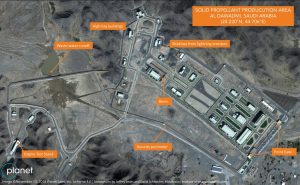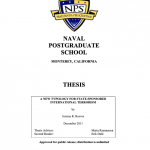“The Middle East is obviously an issue that has plagued the region for centuries” argued former US president Barack Obama. Considering the current political, social and humanitarian crises in the region, the Middle East will undoubtedly remain the main international cauldron for the decade to come. Whether one looks at Syria where big power indirectly clash through their proxies, or in Yemen where a Saudi-led coalition is bogged down in an asymmetrical war against the Iranian-backed Houthis rebels, there is no peace looming in the near future. Yet, notwithstanding the consequences of these fuzzy, fluid and fleeting conflicts, there is no greater threat to international peace and security like the risk of regional nuclear proliferation. While the signing of the JCPOA between Iran and the E3 + 3 group in 2015 augured a certain easing of tensions, the American’s withdrawal from this agreement in 2018 led to the renewal of tensions between Tehran and Washington. This article aims at analyzing the future regional nuclear dynamics, with an emphasis on the resurgence of controversial nuclear activities in Iran and their consequences in the sub-region.
After thirteen years of tense negotiations, Iran and permanent members of the Security Council together with Germany (E3 + 3) signed a nuclear agreement (JCPOA) under which Iran pledged to drastically limit its nuclear program in exchange for a gradual lifting of the cripling sanctions that were imposed on its economy. Despite the fact that Iran had scrupulously fulfilled its international commitments as evidenced by IAEA reports, the US unilaterally denounced this hard-fought agreement. Since then, a cycle of tensions between Washington and Tehran raised international concerns with regards to the resumption of the Iranian nuclear program. Based on Scott Sagan’s proliferation theory, the resumption of the Iranian nuclear program in the current context will depend on several factors. Among them lies the security’s. Although Iran has not yet made the political decision to produce nuclear weapons, the fact that the Natanz plant was recently targeted by an attack (likely fomented by the Americans and Israelis) which damaged the 3/4 of the plant, will reinforce the distrust of the regime’s hawks and lead to greater opacity regarding the Iranian nuclear program.


Furthermore, the imposition of new UN sanctions or the sustaining of the arms embargo in September could lead the Iranian leadership to gradually militarize its nuclear program, given the complete lack of incentive (military or economic) related to the JCPOA. However, notwithstanding the repercussions of the recent attack on Natanz which seriously delayed Iran’s capabilities to produce nuclear weapons, Tehran keeps actual expertise that may allow the Islamic republic to join the nuclear club. Indeed, it is important to emphasize that in addition to political will, the production of a nuclear weapons depends on three technical achievements: the ability to enrich nuclear fuel which grants the explosive charge, the delivery system and the capacity to miniaturize the explosive charge. Of these three elements, Iran lacks delivery expertise and probably the ability to miniaturize the explosive charge; however, the expertise of the Revolutionary Guards keeps improving thanks to the missile and military satellites tests, the last of which harks back to April 2020. One should not rule-out the possibility of a nuclear cooperation with countries like North Korea regarding the miniaturization of the explosive charge. What could be the regional consequences of a nuclear Iran?
Iran’s accession to the inner circle of atomic powers will inevitably have major consequences in an already highly volatile region. Although nations such as Turkey or Egypt are credible candidates for a nuclear status, based on Kenneth Waltz’s theory of balance of power, two key regional actors will be affected by the development of the Iranian nuclear program: Saudi Arabia and the United Arab Emirates (UAE). Regarding the former, Riyadh has never hidden its intention to produce nuclear weapons should Tehran develops a nuclear arsenal. In this regard, Crown Prince Ben Salman declared that “without a doubt, if Iran developed a nuclear bomb, we would follow suit as soon as possible”. But does Riyadh have the means of its mirror policy? Saudi Arabia currently has a nascent nuclear program notwithstanding the stupendous progress achieved so far. However, the American Congress has already expressed its concerns regarding the Saudi project, considering especially the fact that the Saudi’s opposed to the “gold standard” through which a State pledges not to domestically enrich uranium.

With regard to the UAE, the construction of the Barakah nuclear power plant has been completed, however, unlike Riyadh, Abu Dhabi has committed to join the nuclear gold standard, which could foreshadow more nuclear peaceful ambitions than Riyadh’s. Nonetheless, future nuclear decisions of these states will depend on the evolution of the regional geopolitical balances, as well as on the leadership of the big powers to prevent the nuclear club from expanding. In a deeply distrust-based international nuclear order, a horizontal nuclear proliferation could lead to the collapse of the NPT and an existential threat to international peace and security.
Author
-

a PhD candidate at Leiden University, Netherlands where he conducts a research project on the conditions success of coercive diplomacy in the context of nuclear proliferation.
View all posts




